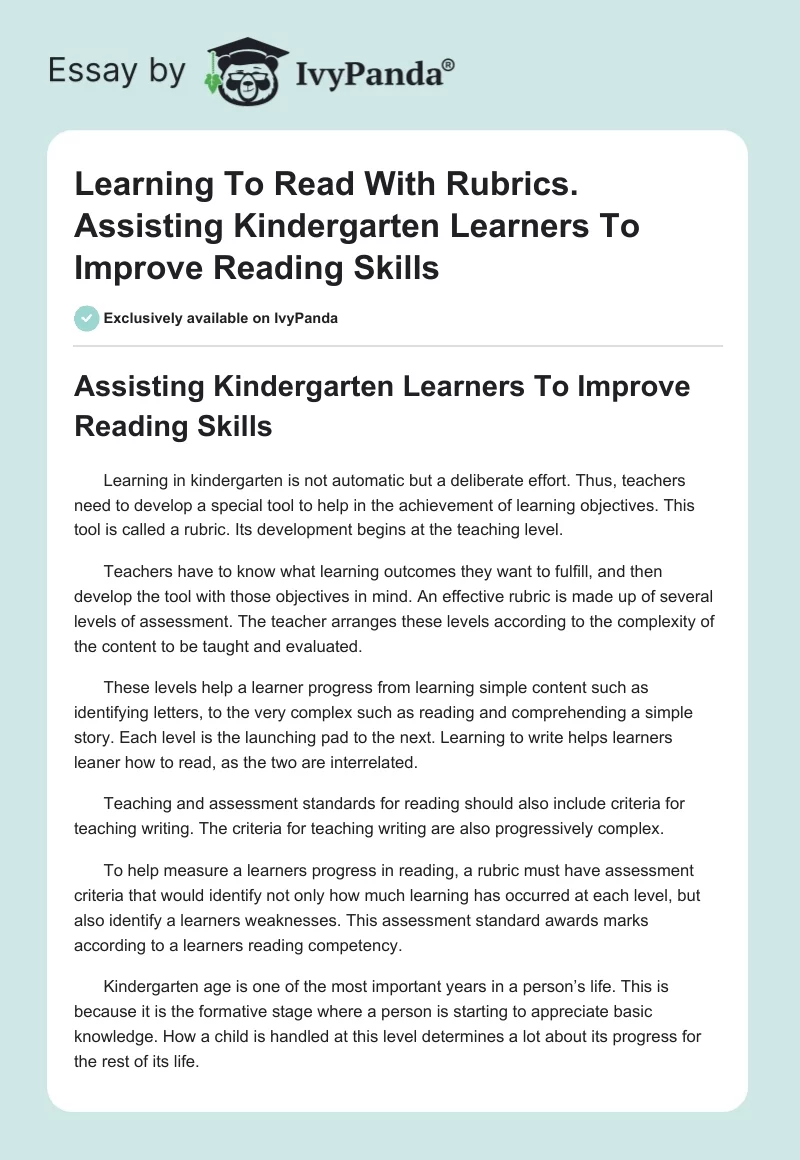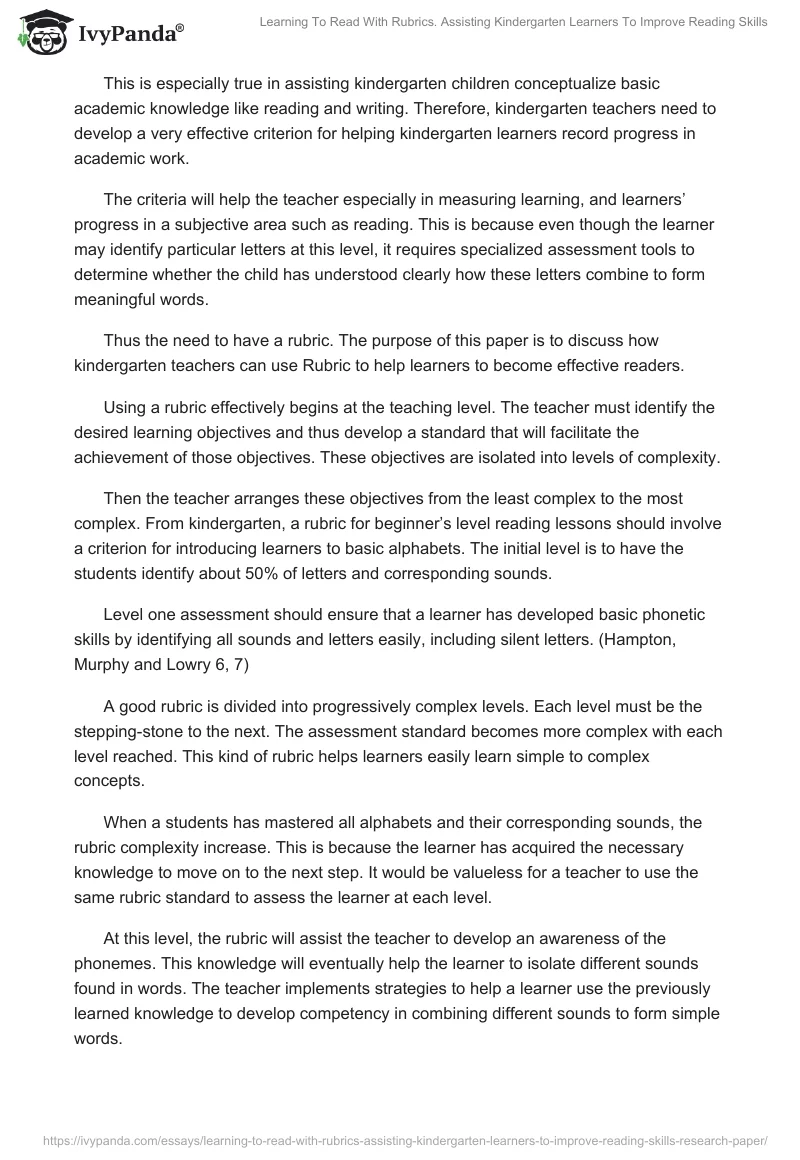Assisting Kindergarten Learners To Improve Reading Skills
Learning in kindergarten is not automatic but a deliberate effort. Thus, teachers need to develop a special tool to help in the achievement of learning objectives. This tool is called a rubric. Its development begins at the teaching level.
Teachers have to know what learning outcomes they want to fulfill, and then develop the tool with those objectives in mind. An effective rubric is made up of several levels of assessment. The teacher arranges these levels according to the complexity of the content to be taught and evaluated.
These levels help a learner progress from learning simple content such as identifying letters, to the very complex such as reading and comprehending a simple story. Each level is the launching pad to the next. Learning to write helps learners leaner how to read, as the two are interrelated.
Teaching and assessment standards for reading should also include criteria for teaching writing. The criteria for teaching writing are also progressively complex.
To help measure a learners progress in reading, a rubric must have assessment criteria that would identify not only how much learning has occurred at each level, but also identify a learners weaknesses. This assessment standard awards marks according to a learners reading competency.
Kindergarten age is one of the most important years in a person’s life. This is because it is the formative stage where a person is starting to appreciate basic knowledge. How a child is handled at this level determines a lot about its progress for the rest of its life.
This is especially true in assisting kindergarten children conceptualize basic academic knowledge like reading and writing. Therefore, kindergarten teachers need to develop a very effective criterion for helping kindergarten learners record progress in academic work.
The criteria will help the teacher especially in measuring learning, and learners’ progress in a subjective area such as reading. This is because even though the learner may identify particular letters at this level, it requires specialized assessment tools to determine whether the child has understood clearly how these letters combine to form meaningful words.
Thus the need to have a rubric. The purpose of this paper is to discuss how kindergarten teachers can use Rubric to help learners to become effective readers.
Using a rubric effectively begins at the teaching level. The teacher must identify the desired learning objectives and thus develop a standard that will facilitate the achievement of those objectives. These objectives are isolated into levels of complexity.
Then the teacher arranges these objectives from the least complex to the most complex. From kindergarten, a rubric for beginner’s level reading lessons should involve a criterion for introducing learners to basic alphabets. The initial level is to have the students identify about 50% of letters and corresponding sounds.
Level one assessment should ensure that a learner has developed basic phonetic skills by identifying all sounds and letters easily, including silent letters. (Hampton, Murphy and Lowry 6, 7)
A good rubric is divided into progressively complex levels. Each level must be the stepping-stone to the next. The assessment standard becomes more complex with each level reached. This kind of rubric helps learners easily learn simple to complex concepts.
When a students has mastered all alphabets and their corresponding sounds, the rubric complexity increase. This is because the learner has acquired the necessary knowledge to move on to the next step. It would be valueless for a teacher to use the same rubric standard to assess the learner at each level.
At this level, the rubric will assist the teacher to develop an awareness of the phonemes. This knowledge will eventually help the learner to isolate different sounds found in words. The teacher implements strategies to help a learner use the previously learned knowledge to develop competency in combining different sounds to form simple words.
The next progressive level involves learners learning how to form simple words beginning with their names. At the end of this level, the learners should be able to read simple words from a wall chart.
This prepares the learner for the next level of learning whereby a learner will develop competence in not only reading words but also forming concepts from words, identifying and correcting simple errors in word formation.
The last level, the learner gains the ability to comprehend simple sentences and explain their meaning. The most successful learners are able to read simple stories (Hampton, Murphy and Lowry 6,7)
Learning a language is two pronged: a learner must know how to read and write. Research has indicated that students who learn quickly how to read also have good writing skills. Schulze explains that reading is all about decoding written messages to make sense.
Learners cannot comprehend the meaning of these words if they do not posses the necessary skills to encoding them (7). Thus, a good rubric for teaching reading must also incorporate writing skills for kindergarten students. As explained earlier, a good rubric is progressively complex.
In teaching writing, a teacher prepares rubric to teach and examine the kindergarten learners’ to differentiate drawing and writing. The next level tests a learner’s competence in differentiating between pictures, letters and numbers.
When a learner is competent at this level, they are able to write letters and words from punctuation and later write sentences (14). Using a rubric to develop writing competence in learners is very useful in developing reading skills as competent learners can read what they write.
Student’s progress cannot be established if no evaluation and assessment standard is in place. This means that a good rubric must focus on assessing students reading ability at different levels through very elaborate assessment criteria. It should contain the following standards.
At the beginners’ level, learners should be assessed on tracing written text from left to write. Those who do it consistently should be awarded very high marks.
Next levels should progress from; a students ability to handle a book properly, identifying the author of the book, reading silent sentences to reading and making meaning out of sentences and short stories.
Those learners who do it consistently enough should be awarded very high marks while those who do not show consistent progress should be awarded average marks depending on the level of consistency (Reading Workshop Rubric n.pgn).
In conclusion, learning for kindergarten children is a procedural activity. It introduces learners to simple facts then progress depending on the learning rate. Kindergarten teachers cannot assume that learners will automatically learn what they are taught.
Learners must be helped to conceptualize knowledge. This is done through a special tool called a rubric. A rubric stipulates instructional methods and the learning outcomes expected at the end of a given time, and how to achieve them. When teachers use a rubric, they can measure the development of their learner’s easily.
Works Cited
Hampton, Sally, Murphy, Sandra and Lowry, Margaret. Using Rubric to Improve Students Writing. Washington: New Standards, 2009. pp 6-7. Print.
Ridley School District. Reading Workshop Rubric (Kindergarten). Web.
Schulze , Arlene. Helping Students Become Better Readers Through Writing. Chicago: International Reading Association, 2006. Print


